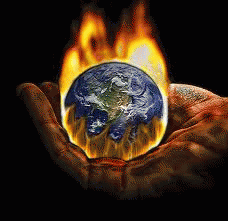>
I fail to understand why global warming and its result, climate change, are seen to be a political or religious issue by so many on the far right. Global warming is a scientific issue, it's real, it's happening and it's dooming our grandchildren, if not our children, to live in a very different, much less hospitable world than the one we know. We can, to a degree, change this but not as long as we give any credence to the religious witch doctors and the political shamans on the fringe arguing from a position of ignorance.
How our planet creates and regulates climate, as opposed to weather, is a tremendously complex process but how excessive emissions of greenhouse gases, the largest concentration of the gasses being carbon dioxide (CO2), causes the planet to warm isn't. It only requires that you understand a little about how the sun's energy reaches Earth, how green house gases interact with reflected infrared radiation and how our planet uses carbon sinks to control the amount of green house gasses in the atmosphere through a complicated feedback system.
Simply stated, the sun's energy reaches the Earth in the form of radiation across the full electromagnetic spectrum from ultraviolet to infrared frequencies. We perceive a part of that radiation as light and heat with radiation in the infrared range accounting for somewhere around half of the heat in our atmosphere. Infrared radiation, after striking the Earth, is mostly reflected back into space, I say mostly because a certain amount of heat is needed to support life on Earth. One of the processes the Earth uses to control its temperature is to store excess CO2 in natural carbon sinks. Primary among these carbon sinks are the oceans and forests, particularly the massive rain forests of South America and Africa. The highly reflective surfaces of the polar ice caps also help control the Earth's temperature by reflecting solar radiation away from the Earth's surface. The fact that CO2 traps heat is not something recently learned; as early as the 1820s the French scientist Joseph Fourier first realized that certain atmospheric gases shrouded the planet like a bell jar, transparent to sunlight, but absorbing some radiation. John Tyndall, an English philosopher and scientist conducted experiments in 1859 which showed that CO2 and water vapor trapped heat and Swedish scientist, Svante Arrhenius, identified CO2 as the primary culprit in 1896.
CO2 is not the only greenhouse gas. Other gases existing in the atmosphere in quantitof concern include methane (CH4), nitrous oxide (N20) and even water vapor. Some less familiar substances contributing to heat retention in the atmosphere are hydrofluorocarbons, perfluorocarbons (both introduced to replace ozone depleting chlorofluorocarbons) and other aerosols , and particulates, mainly dust. Of these, methane is the most troubling because it captures about 30 times the amount of infrared radiation as CO2. Fortunately methane exists in the atmosphere in far smaller quantities. Not so fortunately, billions of tons of methane lies on the ocean floor frozen into a type of ice called methane hydrate or methane clathrate. Methane hydrate melts if it is allowed to warm and once melted it floats on water releasing the gas into the atmosphere. Hydrofluorocarbons are a growing concern because, while they presently exist in very small amounts, some are extremely powerful warming agents and their rapidly growing use as refrigerants and in other commercial applications could cause a seven-fold increase in their contribution to global warming over the next few decades.
Some confusion about planetary warming might come from the fact that the Earth warms and cools in cycles first described by Milutin Milankovich in the early 1900's. The Milankovich cycles are determined by the Earth's tilt (on its axis), wobble on the axis and distance from the sun. They occur in lengths of roughly twenty thousand, forty thousand and one hundred thousand years and aren't a factor in the warming discussed here.
So, if it is clear that an increased concentration of greenhouse gasses causes an increase in the Earth's mean temperature then the question we should be asking is not whether our planet is warming; the question should be are anthropogenic activities causing warming and is that warming a significant cause of climate change. The answer to both is an unqualified yes. As is commonly known, the main culprit in the increase of CO2 in the atmosphere is the use of carbon based fuels, primarily oil, but coal and natural gas also pproduce notable warming agents. At the start of the industrial revolution the concentration of CO2 in the atmosphere was about 290 parts per million (ppm). At present, the concentration is 370 ppm but according to the Special Report on Emission Scenarios from the Intergovernmental Panel on Climate Change (IPCC) that amount could increase to as much as from 490 ppm to 1260 ppm by the end of this century if action isn't taken to control greenhouse gas emissions. A fairly simple calculation reveals that when the CO2 in the atmosphere reaches twice the pre-industrial level, the enhanced greenhouse effect alone, in the absence any response by the earth to the enhanced greenhouse effect, will warm the earth by 1.2 to 1.3˚C. There is no significant controversy among scientists about this part of global warming.
Unhappily, adding to the concentration of greenhouse gasses in the atmosphere is not the only way our activities are causing the Earth to warm. Receiving much less attention but of equal importance are the secondary effects. The polar ice caps mentioned above and large glacial masses reflect much radiation away from the Earth but as the planet warms these areas are growing visibly smaller. Both ice caps are receding and thinning at an increasingly rapid rate and data from the World Glacier Monitoring Service, a program funded by the UN Environment Programme, obtained from close to 30 reference glaciers in nine mountain ranges, indicate that between the years 2004-2005 and 2005-2006 the average rate of melting and thinning more than doubled. Glacier Nation Park may soon have to be renamed. It has 26 glaciers today; it had 150 in 1850. Those that remain are typically mere remnants of their former frozen selves. The Columbia Glacier in Prince William Sound, the world's fastest-melting glacier, slides into the ocean at a rate of 80 feet per day. This glacier is up to 3,000 feet thick but has thinned up to 1,300 feet in places during the past 25 years, and researchers say it's stretching like taffy. Each year, it dumps 2 cubic miles of ice into the sound. In Greenland some glaciers recede as much as several miles in one year. In addition to allowing more heat to be absorbed, the loss of a number of these glaciers has very serious public policy implication as dwindling water supplies causes mass migrations of climate refugees. Nearly a billion people living in South Asia are in danger of losing their water supply.
High school science taught us that plant life absorbs CO2 and produces oxygen. This process means plant life also plays a major role in carbon sequestration, the long term storage of carbon in oceans, soils and vegetation, especially rainforests. Rainforests cover about 7 percent of the Earth's surface and are found in South America, Africa, and Asia. They are tremendously important to CO2 storage and conversion but it is estimated that at least 40 million acres of rainforest, roughly equal to the size of the state of Washington, are cleared each year.
Oceans are the other primary place of carbon sequestration. At present, the oceans hold about 2 Gtons (1 Gton =1 billion metric tons) of CO2 per year, a significant portion of our emissions of 7 Gton CO2 per year. Thanks to a strong faith in a concept called equilibrium, in short, the more CO2 in the atmosphere, the more the oceans would absorb, it was long believed that the capacity of the oceans to store CO2 was such that anthropogenic CO2 would never exceed that capacity. That view is not nearly so strongly held now as research has shown that various conditions are effecting carbon uptake by the oceans. One clearly related to global warming is stratification of the waters in the ocean, due to warming at the surface Stratification tends to inhibit CO2 uptake by slowing the rate of replenishing surface waters by deep waters which haven't taken up CO2 yet.
How a increase in the Earth's mean surface temperature brings about climate change is quite complex and is something I'll tackle in another article. For now, we just need to know that climate change is occurring and it is a product of a warmer planet. We see it in more frequent and stronger hurricanes and typhoons, in more destructive tornados, heavier rains and longer droughts. We see it in colder winters and hotter summers. Extreme weather is quickly becoming the norm. There are those that argue that the Earth has always warmed and cooled and that climate change is a natural phenomenon. That argument has the siren's appeal of having some truth to it. Some believe that global warming is a hoax that the government is perpetrating in order to have more control over our lives. But then, there are those who believe that the Earth is 6,000 years old and Adam and Eve rode on dinosaurs, much like the Flintstones.
The truth is simple and much more resonable, a population of 7 billion places a tremendous strain on not only the Earth's resources but also on the natural processes our planet uses to maintain an environment hospitable to life. None of us welcomes the prospect of having to make serious changes in our lifestyles to preserve that environment and we'd all like to believe that science and ingenuity will keep us from having to do that. They can't and the longer we pretend that this is a political debate the closer we come to a tipping point where nature will make the decisions we couldn't.
Resources for this article include:
The Discovery of Global Warming (New Histories of Science, Technology, and Medicine) by Spencer R. Weart
The Long Thaw: How Humans Are Changing the Next 100,000 Years of Earth's Climate by David Archer
The Weather Makers: How Man Is Changing the Climate and What It Means for Life on Earth by Tim Flannery
Beyond Carbon Dioxide: Growing Importance Of Hydrofluorocarbons (HFCs) In Climate Warming in Science Daily, July 9, 2009 (
http://www.sciencedaily.com)
The Scientific Case for Modern Anthropogenic Global Warming in The Monthly Review, July-August, 2008 (monthlyreview.org)
Rodger Knight is a retired probation officer and amateur historian with a particular interest in the Depression and war years. He has a BA in English and History from Cal State University, San Bernardino and, for two years, was a graduate student (
more...)






